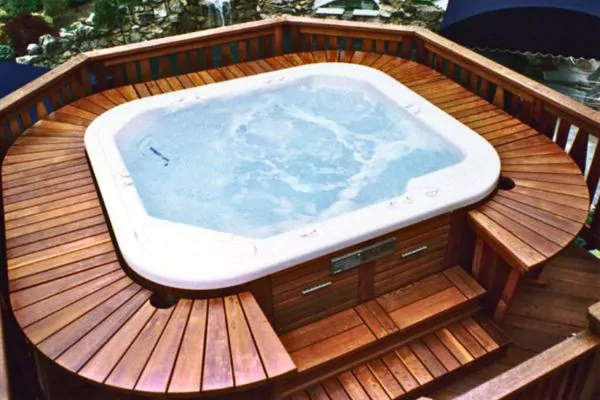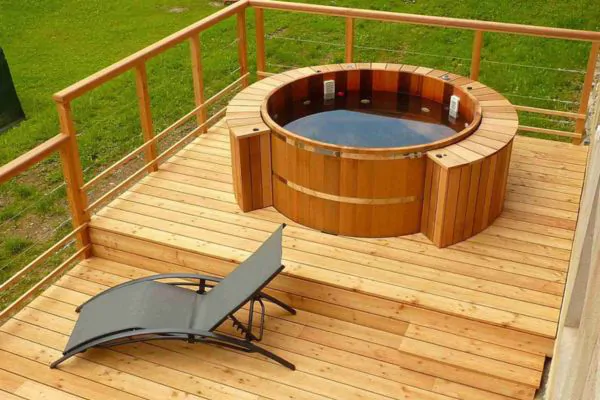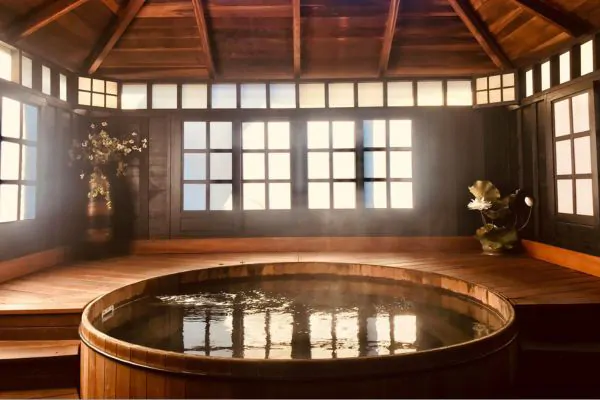Adding a hot tub to your deck offers a luxurious retreat right at home. However, it requires thoughtful planning and robust hot tub deck framing to ensure safety and longevity. The thrill of soaking in warm, bubbling water is matched by the peace of mind knowing your deck can support the considerable weight of a fully loaded hot tub. Incorrect framing can lead to structural failures, costly repairs, and safety hazards. Understanding its fundamentals becomes crucial. Here is everything you need to know about hot tub deck framing and how to make sure it is in tip-top shape.
Benefits of Having a Hot Tub on Your Deck

Integrating a hot tub into your deck brings luxury and enhances your outdoor living experience. Convenient access transforms your backyard into a personal oasis. A strategically designed deck offers privacy from neighbors’ prying eyes, creating a secluded retreat.
Elevated decks provide stunning panoramic views, enhancing the hot tub experience. A hot tub deck also becomes an entertainment centerpiece, where guests can unwind and socialize. Thoughtful construction ensures year-round enjoyment, whether in chilly winter months or warm summer evenings, allowing for a comforting soak whenever the mood strikes.
A. Convenience and accessibility
Incorporating a hot tub into a deck design brings a level of convenience that transforms the way homeowners enjoy their outdoor space. The seamless transition from indoor to outdoor living allows residents to indulge in the soothing waters of a hot tub.
A conveniently designed deck makes it easier to enjoy the tub without the need to trek far from the comfort of their own living space. Accessibility is significantly improved when a hot tub is smoothly integrated within a deck setting, allowing for easy entry and exit at any time. Convenience in accessibility is critical for an effective deck design.
B. Privacy and seclusion
Creating a sanctuary around a hot tub on your deck is as much about crafting a sense of solitude as it is about relaxation. Strategic placement of the hot tub, combined with the proper use of screens and plantings, can shield bathers from the outside world, ensuring a discreet haven for peaceful repose.
The design of a deck with attention to privacy naturally turns a hot tub area into a more intimate setting, offering a retreat where conversations and quiet moments are sheltered from neighboring sights. Thoughtfully planned barriers and landscaping not only enhance the sense of seclusion but also contribute to the overall aesthetic appeal of the outdoor space.
C. Elevated views
Elevating a hot tub deck delivers a unique opportunity to soak in more than just warm water; it allows for an immersion into the surrounding landscape. It keeps you secluded and gives privacy while also feeling safe and comfortable.
Choosing the correct height and positioning of a hot tub on a raised deck could turn a simple soak into an affair with nature, offering views that span across gardens, over treetops, or into the starry night sky. The yard layout and surrounding area need to be considered when planning the location and height of your hot tub deck build.
You might like: Building a Deck: Estimating the Construction Time
D. Entertainment
A deck that is thoughtfully constructed to support a hot tub becomes the ultimate gathering spot for friends and family. It quickly creates an ambient setting ideal for both daytime celebrations and evening gatherings.
The addition of a hot tub elevates the deck from a simple outdoor space to the heart of entertainment and socializing. It offers a place where hosts and guests alike can indulge in the warmth and comfort of the waters while engaging in lively conversations or simply soaking in the joy of each other’s company.
E. Year-round Use
A sturdy hot tub deck is designed to cope with varying weather conditions, making it possible for owners to enjoy their spa throughout the changing seasons. An appropriately built and insulated deck provides a stable and comfortable platform that withstands the cold of winter and the heat of summer, ensuring continuous pleasure from your hot tub all year long.
Thinking about how you plan to use your hot tub year-round will help you find the best way to set it up. Thinking ahead and planning for seasonal challenges and elements will ensure you and your family and friends have a relaxing place to escape to any time of the year.
Key Considerations for Hot Tub Deck Framing
When one ventures into the world of hot tub deck framing, they enter a domain where the usual standards for deck construction are redefined due to the specific demands of hot tub installations.
Selections made during this planning phase might lead to the consideration of setting a hot tub directly onto a concrete pad positioned at ground level, thereby diverting the challenge of reinforcement onto a more traditionally stable foundation that is less susceptible to wood’s natural movement and decay.

A. Weight Support
Addressing weight support in hot tub deck framing requires understanding load distribution. Designers must use adequate beams, joists, and supports to handle the combined weight of the tub, water, and occupants. Reinforcement includes using heftier and more densely spaced components than standard deck construction. This ensures the deck remains sturdy, safe, and reliable over time. Regular deck frames support foot traffic and furniture, but hot tubs need a reimagined structural approach. The deck must be reinforced to prevent structural compromise and safety hazards. A custom framing approach guarantees a secure, enduring deck structure for any hot tub.
B. Structural Reinforcements
Reinforcing a deck for a hot tub requires understanding structural requirements beyond traditional decking. Builders often add extra joists and beams to bolster the designated hot tub space, allowing the deck to handle the added stress and distribute the substantial weight uniformly. Assessing the existing deck framework and identifying weak points are crucial steps. Strengthening it with an additional hot tub deck framing or upgraded materials ensures safety and longevity. Alternatively, placing the hot tub on a ground-level concrete pad provides a firm, stable base, streamlining installation and reducing concerns about wood deterioration over time.
Deck Types for Hot Tubs

When considering a deck for a hot tub, recognize the different designs for aesthetics, function, and safety. Elevated decks create a striking feature but need rigorous reinforcement and adherence to building codes. Isolated hot tub deck framing is required if the deck is positioned atop to support the weight. Each type offers unique considerations for combining a spa with a beautiful, functional deck.
A. Ground or Low-Level Decks
Ground or low-level decks provide an optimal solution for those looking to integrate a hot tub into their outdoor living space without the complexities of a raised structure. These decks are typically flush with the ground and require a thorough understanding of ground-level hot tub deck framing to ensure stability and proper weight distribution.
B. Decks within three feet of the ground
Decks situated close to the ground, specifically within a three-foot height range, cater to those seeking a blend of elevation without venturing too far from the security of the firm earth. These decks offer a practical middle ground, elevated enough to avoid many ground-level concerns like moisture and pests, yet low enough to maintain a sense of intimacy with the surrounding landscape.
C. Decks with Hot Tub on Top
For decks that feature a hot tub perched atop, meticulous reinforcement aligns with a fundamental commitment to safety and durability. The crafting of such decks calls for an adherence to building regulations that prescribe specific strengths and materials suitable for the extra load. Reinforcement goes beyond a mere necessity; it shapes the deck into an enduring foundation that comfortably holds the hot tub, ensuring that the retreat remains a source of relaxation for years to come.
Related Post: Benefits of Using Pressure-Treated Wood for Your Deck
Safety and Accessibility
Navigating the areas around an above-ground hot tub requires careful attention to mitigate tripping and fall risks. A deck built to embrace such a tub should have a layout promoting an unobstructed path, free of protruding edges or unexpected steps, ensuring safety for all users. When designing the deck, prioritize accessibility to the hot tub’s panels and mechanical systems.
Ideal placement allows for hassle-free maintenance and repair without dismantling the deck. Electrical and heating systems must be planned to meet operational needs while adhering to safety standards. Positioning the hot tub should enable a straightforward, safe connection to power sources, with pathways for wiring and equipment that don’t interfere with usability or performance.
V. Aesthetic and Privacy Considerations
When creating an outdoor haven, hot tub deck framing is just the beginning; aesthetics and privacy are vital too. Positioning the hot tub strategically can capture stunning views, while planning for seclusion transforms the space into a private sanctuary. Homeowners can add privacy screens, enclosures, or pergolas to shield their watery oasis and enhance the overall design.
These elements offer both visual appeal and a secluded, personal experience. Carefully considering the tub’s orientation maximizes scenic views or blocks prying eyes, balancing natural beauty with privacy. Installing privacy screens, enclosures, or pergolas enhances the charm of a hot tub deck, blocking unwanted attention and elevating the space’s visual dynamics. This creates an exclusive hideaway that blends seamlessly with the home’s design and that is also comfortable and enjoyable for those who utilize the space.
VI. Building Permits and Local Codes
Delving into hot tub deck framing involves meticulous design and legal considerations. Securing building permits is crucial to ensure compliance with safety requirements and zoning laws. Engaging qualified contractors requires detailed discussions about structural elements like footings, posts, beams, and joists.
These steps pave the way for a structurally sound deck that aligns with building codes, creating a serene and safe relaxation spot. Building permits verify the project’s safety and compliance, ensuring it meets legal standards. Detailed discussions with contractors confirm the deck’s ability to support the hot tub’s weight while maintaining integrity over time.
Working with skilled and experienced deck builders in the area is the best way to ensure your space is up to code and that no hidden issues are lurking!
Conclusion

Proper hot tub deck framing is essential for ensuring the structure can safely support the considerable weight of the tub, water, and occupants. Specialized framing, which may include additional reinforcements and code-compliant materials, prevents potential hazards and prolongs the deck’s lifespan.
Accessibility and aesthetic elements are integral to the design, blending functionality with the visual appeal of the deck. Ultimately, meticulous planning and adherence to local building codes are imperative in creating a reliable and enjoyable hot tub feature on any deck. Call Michigan Deck Builders today to get started on your own hot tub deck design and installation project!


